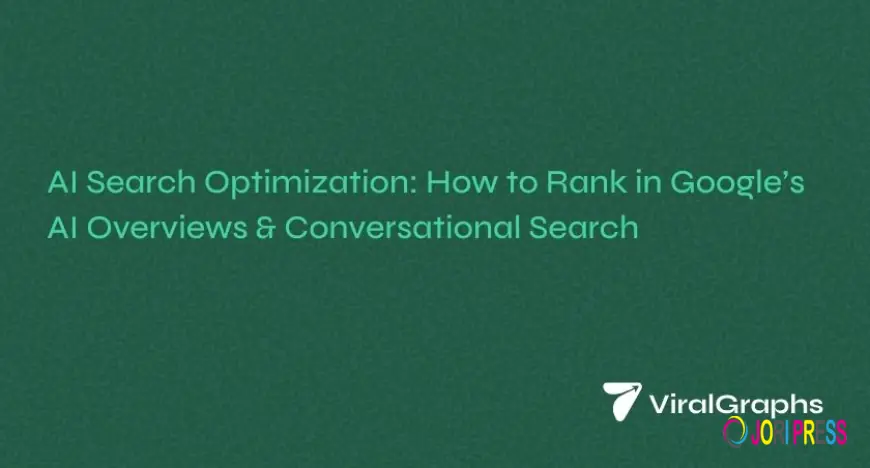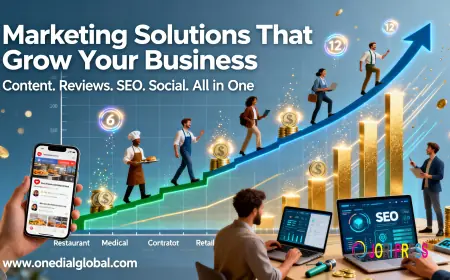AI Search Optimization: How to Rank in Google’s AI Overviews & Conversational Search
AI search is changing how Google evaluates and cites content. Learn how to optimize for AI Overviews and conversational search using entity clarity, structured content, schema markup, topical authority, and freshness. This guide breaks down how Google selects sources and how to format content so AI models consistently reference your pages.

AI search has rewritten the rulebook, and it happened far faster than most teams thought. Users aren’t stopping at the traditional “first 10 sites” anymore. They’re getting instant answers in Google’s AI Overviews, refining them through conversational queries, and making decisions without ever clicking through.
In this new phase of Google Search, your content is not only trying to rank, but also fighting to become the source Google relies on to generate its AI-driven answers.
And, the challenge here is that most SEO strategies are still operating with a pre-AI mindset. They overlook critical factors like entity understanding, structured data extraction, and the trust signals Google’s AI models evaluate before choosing which pages to summarize.
It’s important to understand how AI Overviews select their sources, what conversational search engines prioritize, and which content formats are referenced most consistently.
How Google’s AI Overviews Actually Work
Google’s AI Overviews look complex from the outside, but the logic behind them is surprisingly structured. They don’t pull information from random corners of the web. Instead, they sit on top of Google’s existing systems and rely on three data layers to decide what to include in an AI summary.
These three data layers are as follows:
-
First is the core web index, which still uses traditional ranking factors like relevance, authority, and on-page optimization. If your page isn’t competitive here, it simply won’t enter the AI pipeline.
-
Second is Knowledge Graph data, where Google maps people, brands, and topics into entities. If your brand or topic isn’t clearly defined, AI Overviews often skip you entirely.
-
And the third layer is the AI reasoning model, which summarizes information from sources that Google trusts the most.
The outcome is simple, and that’s, you rank in AI Overviews only when you feed all three layers with clarity, authority, and structured information.
What Conversational Search Prioritizes
Conversational search doesn’t behave like classic SEO, where long-form content and keyword depth often win. When users ask Google follow-up questions like “explain this in simple terms” or “compare these options,” the AI shifts into a mode that rewards clarity over volume.
It focuses on content that is direct, specific, and structured. Pages that break concepts into steps, definitions, bullets, or short actionable insights are far more likely to be referenced. Google’s conversational engine also checks for consistency across the web. If multiple reputable sites repeat the same information, that data becomes more “trustworthy” to the AI model.
Another key signal is entity trust. When Google clearly recognizes who you are and what you’re an authority on, your content becomes a more reliable answer source during conversational flows. If your writing is vague or overly padded, conversational search will simply look elsewhere.
The 7 Ranking Factors That Matter for AI Search
Ranking in AI Overviews isn’t random. Google’s AI relies on a predictable set of signals to decide which pages deserve to be summarized and which ones stay invisible.
These signals aren’t the same as classic SEO ranking factors. Some overlap, but AI models pay closer attention to clarity, structure, trust, and topical depth. If your content doesn’t match what the AI can easily read or confidently validate, it simply won’t reference you.
Here are the seven signals that matter most when you want to show up in Google’s AI Overviews and conversational search.
1. Entity Recognition
AI Overviews don’t guess, as they lean heavily on entities, like people, brands, products, and topics that Google already understands. If your brand isn’t clearly mapped in the Knowledge Graph, your chances drop instantly.
You can strengthen this through consistent naming, detailed author bios, organization schema, and complete profiles across platforms like LinkedIn, Crunchbase, and industry directories. The clearer your identity, the easier it is for Google’s AI to trust you.
2. Content Structure
AI models scan pages for structure. The more well-organized your content, the more easily AI Overviews can pull from it.
Formats like step-by-step lists (H1/H2/H3), definition blocks, comparison tables, bullets, and key takeaways are ideal. Dense paragraphs slow the model down. Clear formatting speeds up extraction.
3. Precision Over Length
Traditional SEO rewarded long-form pages. AI search does the opposite.
It cites answers that are sharp, direct, and specific. Cut long intros, remove filler, and get straight to the point with statements that read like ready-made summaries.
4. Topical Authority Clusters
AI Overviews want to cite domain experts. You build that impression by creating clusters, i.e., multiple in-depth pages around your core topic.
When Google sees consistent expertise across several related articles, your pages rise in both traditional and AI-driven rankings. Clusters show depth, and AI rewards that.
5. High-Authority Mentions (Digital PR)
AI systems validate your credibility by checking whether recognizable publications mention you. Mentions in top-tier sites, well-known industry blogs, government or educational sources, and high-quality listicles act as trust signals.
These sources help AI confirm your legitimacy.
6. Schema Markup (The underrated differentiator)
A schema gives Google a structured understanding before the AI even starts summarizing.
Adding FAQ, HowTo, Article, Organization, and Product schema helps Google analyze your page more confidently. A clean schema means higher inclusion probability.
7. Freshness Signals
AI leans towards recent information. Pages updated within three to six months tend to appear more often in AI Overviews.
Regular updates, like new examples, new data, and refreshed steps, reinforce that your content is current and reliable.
How to Structure Content That AI Overviews Actually Cite
If you want your pages to appear in AI Overviews more often, the format of your content matters just as much as the context.
AI models look for sections that are easy to read, easy to analyze, and easy to summarize. That means your layout should guide the AI rather than force it to hunt through long paragraphs.
You can do this:
-
Start with a 2 to 3-sentence summary answer at the very top. This gives the AI an instant, high-quality snippet to work from.
-
Follow that with bullet points or short, direct statements that break down the key ideas.
-
Add a step-by-step explanation if you're teaching a process, AI loves logic it can trace.
-
Insert comparison tables for scenarios involving tools, strategies, or pros and cons, as tables are one of the fastest structures for AI extraction.
-
Finally, include a compact FAQ section at the bottom. These question–answer blocks are often used by AI models during conversational follow-ups.
When your page feels like a summary, and not long-form content, AI Overviews are far more likely to cite it.
How to Measure Success in AI Search?
The toughest part of optimizing for AI search is figuring out whether your efforts are actually working. Traditional SEO tools weren’t built to monitor AI Overviews or conversational answer citations, which means you need a more practical, self-defined measurement framework.
Start by running a consistent weekly test across Google, Gemini, ChatGPT, and Perplexity using your target keywords. Track whether your brand, URL, or insights appear in their generated responses.
Then review Google Search Console for AI Overviews impressions. Google is rolling this out gradually, and it’s currently the closest thing to an official metric for AI visibility.
From there, build an internal AI Visibility Score with five key inputs:
-
Mentions of your brand across AI tools.
-
Strength of your entity clarity (schema, profiles, structured data).
-
Presence of structured formats (tables, FAQs, comparisons).
-
Content freshness and update consistency.
-
Citations or references from authoritative third-party sources.
If these indicators trend upward, you’re moving in the right direction and becoming a source Google is more likely to rely on within its AI-driven ecosystem.
How to Future-Proof Your AI SEO Strategy
AI search is moving fast, and the strategies that work today may look different a year from now. Hence, the safest approach is to build a strategy that adapts as Google evolves.
What you can do is:
-
Start by embracing multimodal search, where images, videos, and structured visuals become part of how AI answers questions.
-
Prioritize voice-friendly content, since conversational queries are increasingly spoken rather than typed.
-
Expect Google to rely more on entity trust and semantic authority than backlinks alone, making clarity and credibility essential.
And as real-time browsing becomes more common in AI tools, freshness will matter even more. The goal is simple, and that is to stay updated, stay structured, and stay authoritative.
Also Read - AI Content Marketing in 2026: From SMART Scaling to AI Search Visibility
Conclusion
AI Overviews and conversational search aren’t replacing SEO, but they’re expanding it. The brands that win now are the ones who write with clarity, structure their content for easy extraction, and build enough authority for Google to trust their insights.
Start by tightening your formatting, strengthening your entity signals, updating your pages regularly, and creating topic clusters that make your expertise unmistakable.
The more your content feels like a summary, the more often AI will reference it. When answers are instant, then being the source behind those answers is the real advantage.
What's Your Reaction?
 Like
0
Like
0
 Dislike
0
Dislike
0
 Love
0
Love
0
 Funny
0
Funny
0
 Angry
0
Angry
0
 Sad
0
Sad
0
 Wow
0
Wow
0



















































